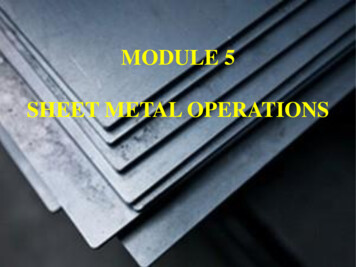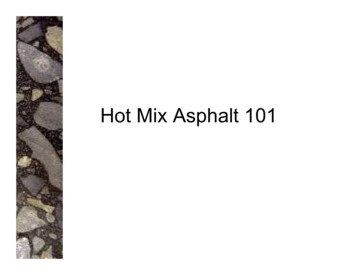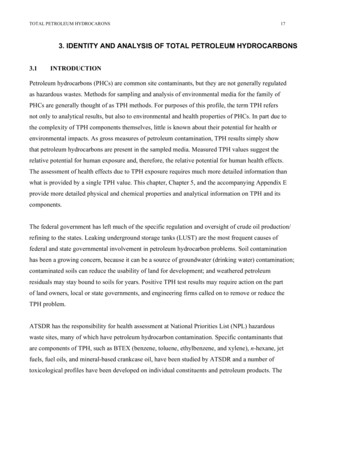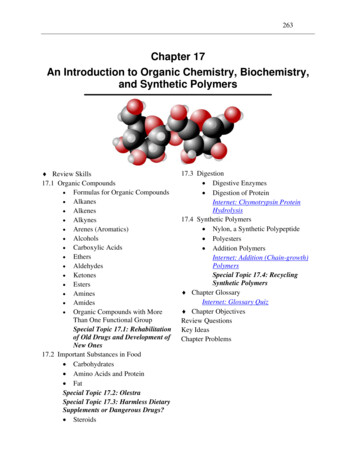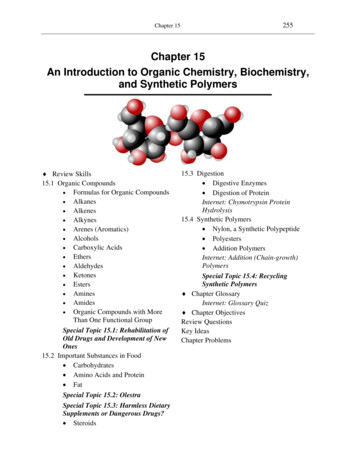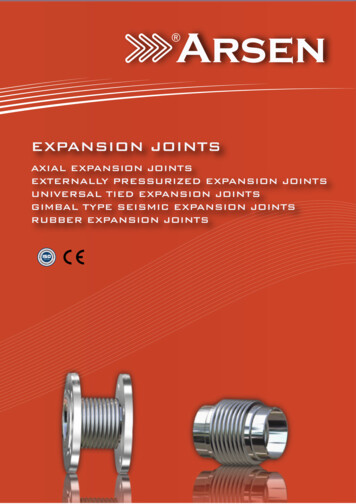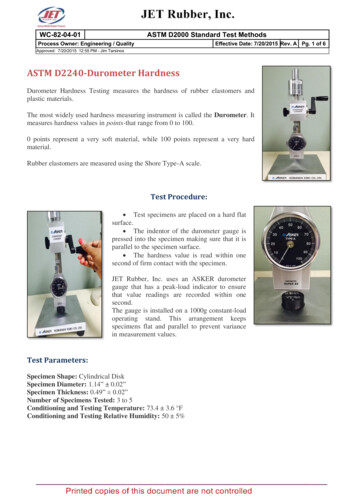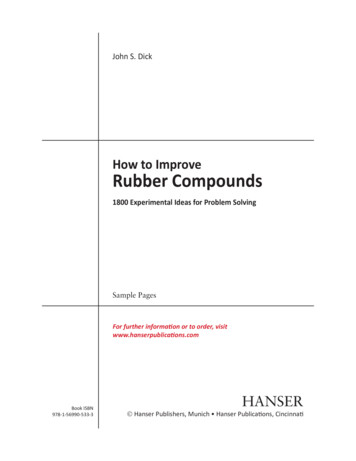
Transcription
John S. DickHow to ImproveRubber Compounds1800 Experimental Ideas for Problem SolvingSample PagesFor further informaƟon or to order, visitwww.hanserpublicaƟons.comBook ISBN978-1-56990-533-3HANSER Hanser Publishers, Munich Hanser PublicaƟons, CincinnaƟ
3Improving DegradationResistance of CuredRubber Compounds 3.1 Improving Hot Air and/or Heat AgingResistanceHot air aging and heat aging resistance are becoming very important today, especially in automotive applications where “under-the-hood” operating temperatureshave been increasing and there is more pressure from automotive manufacturersto have rubber parts that last longer (part of the move toward a 150,000-mile carwarranty!). Anaerobic heat aging resistance can be quite different from hot airaging resistance. For example, a rubber compound might possess good reversionresistance (anaerobic), yet still be subject to oxidative attack (or vice versa). Thetype of aging properties that a cured rubber compound possesses is very importantin determining how that compound will be classified in accordance with SAEJ200/ASTM D2000 for automotive applications.The following experimental ideas might improve a rubber compound’s hot airaging resistance and/or heat aging resistance (but not always both). Also, allrelevant literature sources, including the ones cited below, should be researchedand read. Caution: these general experimental ideas may not work in all specificsituations. Changes to improve hot air aging or heat aging resistance will certainlyaffect other properties as well, for better or for worse, and this book does not purportto show how these other properties are affected. Also, this book does not purportto address safety and health issues.Subjective Ranking of RubberOne overall subjective ranking that can be applied to different base elastomersfor heat resistance is as follows:FKM (Best) VMQ Fluorosilicone ACM AEM EPDM CO/ECO CM CSM NBR CR IIR NBR/PVC SBR NRRT: Rubber Technology, Compounding and Testing for Performance. 2nd ed. Edited by J. S. Dick, Hanser Publications, 2009 GEN: GeneralReferences from the Literature RP: Review Panel (Advisors for this book) IMPORTANT: The information contained herein is experimentalin nature and is meant for individuals with advanced scientific training and rubber compounding experience. All safety precautions should betaken when replicating or applying this information. The author makes no representation or warranty, either expressed or implied.
1263 Improving Degradation Resistance of Cured Rubber CompoundsGEN: J. Horvath, “Selection of Polymers for Automotive Hose and Tubing Applications,” Rubber World, December 1987, p. 21.Another subjective ranking that can be applied to base elastomers for heatresistance is the following:FKM (Best) TFE VMQ/PVMQ/MQ FVMQ AEM EPM EPDM ACM CSM CR NR NBR AU/EU SBR/BRGEN: R. Mastromatteo, E. Morrisey, M. Mastromatteo, H. Day, “MatchingMaterial Properties to Application Requirements,” Rubber World, February,1983, p. 28.The so-called “continuous use” temperature rankings for specialty elastomerswere reported as follows:Type of rubberContinuous use temperatureHNBR145 C (293 F)ACM150 C (302 F)AEM160 C (320 F)AG (DAI-EL Alloy AG-1530)175 C (347 F)FKM230 C (446 F)GEN: M. Kishine, T. Noguchi, “New Heat-Resistance Elastomers,” Rubber World, February, 1999, p. 40.PerfluoroelastomersOften perfluoroelastomers (FFKMs) are selected as the base rubber for acompound when the ultimate heat resistance is needed. FFKM polymers reportedly can impart useful service life at temperatures as high as 316 C (601 F).GEN: M. Coughlin, R. Schnell, S. Wang, “Perfluoroelastomers in Severe Environments: Properties, Chemistry, and Applications,” Presented at ACS RubberDiv. Meeting, Spring, 2001, Paper No. 24.FluoroelastomersCompounds based on FKM possess extremely good heat aging resistance. RT:Chapter 6, “Elastomer Selection,” R. School, p. 135.Fluoroelastomer (FKM) compounds can achieve heat resistance up to 260 C(500 F). GEN: M. Chase, “Roll Coverings Past, Present, and Future,” Presentedat Rubber Roller Group Meeting, New Orleans, May 15–17, 1996, p. 7.To maximize compound high-temperature performance, the best acceptor for thechosen FKM must be selected. Common types of acceptors for FKM compoundsare low-activity magnesium oxide, high-activity magnesium oxide, calciumRT: Rubber Technology, Compounding and Testing for Performance. 2nd ed. Edited by J. S. Dick, Hanser Publications, 2009 GEN: GeneralReferences from the Literature RP: Review Panel (Advisors for this book) IMPORTANT: The information contained herein is experimentalin nature and is meant for individuals with advanced scientific training and rubber compounding experience. All safety precautions should betaken when replicating or applying this information. The author makes no representation or warranty, either expressed or implied.
3.1 Improving Hot Air and/or Heat Aging Resistanceoxide, calcium hydroxide, zinc oxide, and lead oxide (litharge), which is toxic.RT: Chapter 6, “Elastomer Selection,” R. School, p. 136.Fluoroelastomer-based compounds provide extremely good protection againstair aging and can provide a “useful service life” at temperatures greater than200 C (392 F). RT: Chapter 8, “Specialty Elastomers,” R. Stevens, p. 229.For even better heat aging resistance of a fluoroelastomer compound, select abisphenol AF cure system. RT: Chapter 8, “Specialty Elastomers,” R. Stevens,p. 230.New fluoroelastomers made with vinylidene fluoride, tetrafluoroethylene, andpropylene reportedly possess better aging properties for many “aggressiveengine oils” at high temperatures compared to conventional FKM elastomers.This is reported to be attributable to the use of propylene in place of hexafluoropropylene in the polymerization process. GEN: W. Grootaert, R. Kolb, A. Worm,“A Novel Fluorocarbon Elastomer for High-Temperature Sealing Applicationsin Aggressive Motor-Oil Environments,” Rubber Chemistry and Technology,September–October, 1990, Vol. 63, p. 516.The following is a general ordinal ranking of different types of fluoroelastomersin regards to the heat resistance they impart to a rubber compound:FFKM ( 72% F) Best FKM Type 2 ( 70% F) FKM Type 1 ( 65% F)GEN: Jim Denham (3M), “Basic Fluoroelastomer Technology,” Presented at theEnergy Rubber Group, September 13, 2011, Galveston, TX.Under severe conditions of very high pressure and very high temperature (HPHT)in “down-hole” oil drilling operations using fluoroelastomer compounds, to helpavoid explosive decompression (ED) as a mode of failure, consider using thenew ultra-high-viscosity (UHV) fluoroelastomers [ML (1 10 @ 121 C) 150],66% fluorine content, bisphenol AF curable. GEN: J. Denham (Dyneon 3M),“Solutions for the Oil and Gas Industry,” Presented at the Spring Meeting ofthe Energy Rubber Group, May 28, 2009, Arlington, TX.HNBRCompounds based on HNBR possess very good heat aging resistance. The higherthe level of hydrogenation is, the better the heat aging will be because thereare fewer unsaturated sites on the polymer backbone that can be attacked. RT:Chapter 8, “Specialty Elastomers,” M. Wood, p. 202.Some grades of HNBR can be sulfur cured because they still possess someunsaturation. However, an HNBR compound will usually possess better heataging resistance if it is cured with peroxide instead of sulfur. RT: Chapter 8,“Specialty Elastomers,” M. Wood, p. 202.RT: Rubber Technology, Compounding and Testing for Performance. 2nd ed. Edited by J. S. Dick, Hanser Publications, 2009 GEN: GeneralReferences from the Literature RP: Review Panel (Advisors for this book) IMPORTANT: The information contained herein is experimentalin nature and is meant for individuals with advanced scientific training and rubber compounding experience. All safety precautions should betaken when replicating or applying this information. The author makes no representation or warranty, either expressed or implied.127
1283 Improving Degradation Resistance of Cured Rubber CompoundsTOTM and TINTM plasticizers reportedly impart better heat resistance forHNBR compounds than plasticizers such as DOP and DBEEA because thesetrimellitate plasticizers have lower volatility and higher molecular weights.DBEEA reportedly is the “most recommended” for HNBR-based, sulfur-curedcompounds because it imparts a good balance between low-temperatureproperties and heat resistance. GEN: S. Hayashi, H. Sakakida, M. Oyama,T. Nakagawa, “Low-Temperature Properties of Hydrogenated Nitrile Rubber(HNBR),” Rubber Chemistry and Technology, September–October, 1991, Vol. 64,p. 534.NBRHigh-temperature applications for NBR-based compounds often use peroxidesand thiurams as curatives. RT: Chapter 6, “Elastomer Selection,” R. School,p. 131.Using NBR grades with higher ACN content may improve compound heat agingresistance. RT: Chapter 8, “Specialty Elastomers,” M. Gozdiff, p. 194.Use an emulsion NBR that is produced from a coagulating system based onmagnesium sulfate for better heat resistance. RT: Chapter 8, “Specialty Elastomers,” M. Gozdiff, p. 196.To impart better heat resistance to a nitrile formulation, consider ether thioetherplasticizers, in which the sulfur functions as a secondary antioxidant. GEN:J. Dunn, “Compounding Elastomers for Tomorrow’s Automotive Market, Part II,”Elastomerics, February, 1989, p. 29.To impart better heat resistance to a nitrile formulation, consider using precipitated silica, magnesium oxide, and zinc oxide in place of carbon black. GEN:J. Dunn, “Compounding Elastomers for Tomorrow’s Automotive Market, Part II,”Elastomerics, February, 1989, p. 29.Natural RubberFor NR compounds, cure at a lower temperature for a longer period of time toincrease the preponderance of monosulfide crosslinks for better aging properties. GEN: M. Studebaker, J. Beatty, “Vulcanization,” Elastomerics, February,1977, p. 41.For NR formulations, selecting diphenylguanidine (DPG) as the secondaryaccelerator (“kicker”) instead of a dithiocarbamate or a thiuram “kicker” for aprimary accelerator may improve the compound’s heat aging characteristics.GEN: B. Ashworth, K. Crawford, “Effect of Secondary Accelerator Selectionon the Aging Characteristics of Natural Rubber Vulcanizates,” Rubber World,December, 1982, p. 20.RT: Rubber Technology, Compounding and Testing for Performance. 2nd ed. Edited by J. S. Dick, Hanser Publications, 2009 GEN: GeneralReferences from the Literature RP: Review Panel (Advisors for this book) IMPORTANT: The information contained herein is experimentalin nature and is meant for individuals with advanced scientific training and rubber compounding experience. All safety precautions should betaken when replicating or applying this information. The author makes no representation or warranty, either expressed or implied.
3.1 Improving Hot Air and/or Heat Aging ResistanceNever use nickel dibutyldithiocarbamate (NBC) in a natural rubber compoundbecause NBC is a strong pro-oxidant and degradant to NR. RT: Chapter 19,“Antidegradants,” F. Ignatz-Hoover, p. 453.Cardanol–formaldehyde (CF) novolak curing resin can be used with HMTAto cure a natural rubber compound so as to impart good aging properties.CF novolak curing resins are more compatible with NR than phenol–formaldehyde novolak curing resins. In addition, the CF resins have some antioxidantproperties. The CF resins are manufactured using cardanol as a raw material.Cardanol is usually extracted from CNSL or “cashew nut shell liquid,” whichis relatively inexpensive and a natural product. GEN: Y. Vu, J. Mark, L. Pham,“Blends of Natural Rubber with Cardanol-Formaldehyde Resins,” Presented atACS Rubber Div. Meeting, Spring, 1998, Paper No. 58.Consider using a diurethane cure (Novor crosslinking agents from HughsonChemical Co.), which reportedly impart better heat aging resistance to a NRvulcanizate. GEN: T. Kempermann, “Sulfur-Free Vulcanization Systems for DieneRubber,” Rubber Chemistry and Technology, July–August, 1988, Vol. 61, p. 422.For an all-natural rubber motor mount, consider applying a curable formulatedchloroprene/polyoctenamer undercoat (drying the solvent) followed by the application of a formulated curable halobutyl/polyoctenamer top coating followedby drying. When properly applied and cured on the surface of the NR motormount, this two-layer coating serves as an effective barrier against ozone attackas well as thermooxidative attack of the natural rubber. It significantly slowsdown the diffusion of ozone and oxygen into the NR and prevents the cleavageof the backbone of the NR molecules. Reportedly, fatigue cycling testing of NRmotor mounts showed that the two-layer coating improved the cycles-to-failureresults significantly. GEN: H. Graf, E. Sayej, “Reversion Resistance of EngineMounts,” Rubber World, February, 2000, p. 55.Consider coating products of natural rubber with a thin layer of HXNBR tohelp prolong high-temperature service life. GEN: Rani Joseph (Cochin University, India), “HXNBR for Improving Ageing Resistance of Natural RubberProducts,” Paper No. 1 presented at the Fall Meeting of the Rubber Division,ACS, November 1–3, 2005, Pittsburgh, PA.PolychloropreneW-type neoprenes generally impact better heat aging properties to a vulcanizatethan G-type neoprene. RT: Chapter 6, “Elastomer Selection,” R. School, p. 133;Chapter 8, “Specialty Elastomers,” L. L. Outzs, p. 208.Octylated diphenylamine is reported to be one of the better antioxidants forpolychloroprene- based compounds. GEN: R. Tabar, P. Killgoar, R. Pett, “A FatigueRT: Rubber Technology, Compounding and Testing for Performance. 2nd ed. Edited by J. S. Dick, Hanser Publications, 2009 GEN: GeneralReferences from the Literature RP: Review Panel (Advisors for this book) IMPORTANT: The information contained herein is experimentalin nature and is meant for individuals with advanced scientific training and rubber compounding experience. All safety precautions should betaken when replicating or applying this information. The author makes no representation or warranty, either expressed or implied.129
1303 Improving Degradation Resistance of Cured Rubber CompoundsResistant Polychloroprene Compound for High Temperature Dynamic Applications,” Rubber Chemistry and Technology, September–October, 1979, Vol. 52,p. 781.Reportedly, for better AO protection for a CR compound, try Stalite S (octylateddiphenylamine) at 4 phr, Aranox (N-phenyl-N′-Cp-toluenesulfonyl) at 1 phr,zinc oxide at up to 10 phr, and magnesium oxide up to 6 phr. GEN: L. Outzs,“Neoprene,” Presented at the DuPont Compounders Course, May, 2006,Fairlawn, OH.EVMEthylene vinyl acetate (EVM), sometimes called the “forgotten rubber,” possessesgood resistance to heat aging when properly compounded because it possesses asaturated backbone. Because of this fact, EVM is being used more in automotiveseal and gasket applications where good heat aging resistance is needed. TheEVM grades that contain a vinyl acetate content between 40 and 80% are goodelastomers for rubber applications. GEN: R. Pazur, L. Ferrari, H. Meisenheimer(Bayer Inc.), “Ethylene Vinyl Acetate Copolymers: The Forgotten Rubber,”Paper No. XVI presented at the Spring Meeting of the Rubber Division, ACS,May 17–19, 2004, Grand Rapids, MI.EPDMEPDM reportedly can be compounded to have heat resistance up to 125 C(257 F). GEN: K. Dominic, V. Kothari, “Overview of Automotive Wire and Cableand Recent Advances,” ACS Rubber Division Meeting, Spring, 1998, PaperNo. 32, p. 13.Using peroxide to cure an EPDM compound will improve its heat aging resistance. RT: Chapter 6, “Elastomer Selection,” R. School, p. 132.Low-Viscosity, Gas-Phase EPDM Needs Less OilTry compounding with an ultra-low Mooney viscosity gas-phase polymerizedEPDM with very high ethylene content and filler loading. Higher ethylenecontent reportedly improves the processability of the compound withoutdependency on the use of traditional processing oils and plasticizers, whichcan sometimes impart poor hot air aging properties. GEN: A. Paeglis, “Very LowMooney Granular Gas-Phase EPDM,” Presented at ACS Rubber Div. Meeting,Fall, 2000, Paper No. 12.RT: Rubber Technology, Compounding and Testing for Performance. 2nd ed. Edited by J. S. Dick, Hanser Publications, 2009 GEN: GeneralReferences from the Literature RP: Review Panel (Advisors for this book) IMPORTANT: The information contained herein is experimentalin nature and is meant for individuals with advanced scientific training and rubber compounding experience. All safety precautions should betaken when replicating or applying this information. The author makes no representation or warranty, either expressed or implied.
3.1 Improving Hot Air and/or Heat Aging ResistanceEPDM/CRConsider adding a small quantity of CR (or other chlorinated polymer) to aperoxide-cured EPDM compound to improve the compound’s heat resistance.GEN: R. Ohm, R. Annicelli, T. Jablonowski, C. Lahiri, R. Mazzeo, “Optimizingthe Heat Resistance of EPDM and NBR,” ACS Rubber Div. Meeting, Fall, 2000,Paper No. 99, p. 5.EPDM/CR AlloyConsider developing a rubber compound based on a blend of 70 phr ofNeoprene GRT, 30 phr of EPDM, with a compatibilizer of escor acid terpolymerat 10 phr (ethylene–methacrylate–acrylic acid terpolymer), which displayssuperior DeMattia cut growth resistance, heat resistance, and ozone resistance,which is claimed to be good for many power transmission belt applications.GEN: P. Arjunan, R. Kusznir, A. Dekmezian, “Compatibilization of CR/EPMBlends for Power Transmission Belt Applications,” Rubber World, February,1997, p. 21.EPDM/POEEPDM compound heat aging resistance can be improved by blending with polyolefin elastomer (POE). RT: Chapter 6, “Elastomer Selection,” R. School, p. 139.Butyl and HalobutylConsider using compounds based on butyl and halobutyl rubber insteadof general purpose rubber. RT: Chapter 8, “Specialty Elastomers,” G. Jones,D. Tracey, A. Tesler, p. 174.ExxonMobil’s Exxpro (BIMSM, brominated copolymer of isobutylene andparamethylstyrene) has no unsaturation in its backbone. Therefore, BIMSMhas more heat resistance than halobutyl rubbers, which do possess a smalllevel of unsaturation in their backbone. Therefore, using BIMSM in place ofhalobutyl rubber in the tire innerliner may result in the innerliner being moreheat resistant, thus improving the service life of the tire innerliner undersevere service conditions. GEN: G. Jones, “Exxon’s Exxpro Innerliner for SevereService Tire Applications,” Presented at the 1996 ITEC Meeting, September,1996, Akron, OH.HIIRHalobutyl rubber may provide better resistance to heat aging than regular butylrubber cured with a conventional sulfur vulcanization system. RT: Chapter 8,“Specialty Elastomers,” G. Jones, D. Tracey, A. Tisler, p. 185.RT: Rubber Technology, Compounding and Testing for Performance. 2nd ed. Edited by J. S. Dick, Hanser Publications, 2009 GEN: GeneralReferences from the Literature RP: Review Panel (Advisors for this book) IMPORTANT: The information contained herein is experimentalin nature and is meant for individuals with advanced scientific training and rubber compounding experience. All safety precautions should betaken when replicating or applying this information. The author makes no representation or warranty, either expressed or implied.131
1323 Improving Degradation Resistance of Cured Rubber CompoundsHigher heat resistance is obtained with halobutyl rubber when cured with bismaleimide (HVA-2) either with or without peroxide. RT: Chapter 8, “SpecialtyElastomers,” G. Jones, D. Tracey, A. Tisler, p. 186.Cure bromobutyl-based compound with a proprietary curative called Vanax 189from R. T. Vanderbilt for significantly improved heat aging resistance. Vanax 189is a derivative of 1,2-dimercapto-1,3,4-thiadiazole. GEN: R. Ohm, “New Developments in Curing Halogen-Containing Polymers,” Presented at ACS Rubber Div.Education Symposium No. 45, “Automotive Applications II,” Spring, 1998, p. 4.Consider curing a halobutyl compound with zinc oxide and certain diamineAOs such as di-beta-naphthyl-p-phenylenediamine (Agerite White ). Thismay improve the compound’s heat resistance. (The mechanism may involve aFriedel–Crafts alkylation reaction.) GEN: J. Dunn, “Compounding Elastomersfor Tomorrow’s Automotive Market, Part II,” Elastomerics, 1989, p. 28.Using a substituted p-phenylenediamine AO such as N,N′-di-beta-naphthyl-pphenylene-diamine (DNPD or Agerite White ) and zinc oxide as crosslinkingagents for a bromobutyl-based compound may improve air aging resistance.GEN: D. Edwards, “A High-Pressure Curing System for Halobutyl Elastomers,”Rubber Chemistry and Technology, March–April, 1987, Vol. 60, p. 62.In tire innerliner compounds, use less natural rubber and more halobutyl rubberto improve heat resistance. GEN: W. Waddell, R. Napler, D. Tracey, “NitrogenInflation of Tires,” Paper No. 45 presented at the Fall Meeting of the RubberDivison, ACS, October 14–16, 2008, Louisville, KY.BIIR vs. CIIRCompounds based on BIIR may give slightly better heat resistance than thosebased on CIIR. GEN: J. Fusco, “New Isobutylene Polymers for Improved TireProcessing,” Presented at the Akron Rubber Group Meeting, January 24, 1991,Akron, OH.BIMSUse Exxon’s EXXPRO (polyisobutylene with brominated p-methylstyrene curesite) for further heat resistance over regular halobutyl rubber, which relies onunsaturation sites as cure sites. GEN: R. Ohm, “New Developments in CuringHalogen-Containing Polymers,” Presented at ACS Rubber Div. EducationSymposium No. 45, “Automotive Applications II,” Spring, 1998, p. 5.Brominated isobutylene-co-p-methylstyrene (BIMS)-based compounds may havebetter heat aging properties than a conventional halobutyl rubber compoundunder more severe temperatures such as 125 C (257 F) or 150 C (302 F). GEN:G. Jones, “Exxpro Innerliners for Severe Service Tire Applications,” Presentedat ITEC, 1998, Paper No. 7A.RT: Rubber Technology, Compounding and Testing for Performance. 2nd ed. Edited by J. S. Dick, Hanser Publications, 2009 GEN: GeneralReferences from the Literature RP: Review Panel (Advisors for this book) IMPORTANT: The information contained herein is experimentalin nature and is meant for individuals with advanced scientific training and rubber compounding experience. All safety precautions should betaken when replicating or applying this information. The author makes no representation or warranty, either expressed or implied.
3.1 Improving Hot Air and/or Heat Aging ResistanceAvoid Zinc for CM and CSMFor compounds based on chlorinated polyethylene (CM) or chlorosulfonatedpolyethylene (CSM), avoid incorporating any zinc-containing materials intothe formulations or in any way using any zinc-containing coatings or dustingagents that might come in contact with these formulations because they willseriously degrade heat resistance and state of cure. RT: Chapter 8, “SpecialtyElastomers,” L. Weaver, C. Baddorf, pp. 212, 215.CRGenerally, mercaptan-modified neoprene has better heat resistance than thesulfur-modified or xanthate-modified neoprene. GEN: Nobuhiko Fujii, DenkiKagaku Kogyo K. K. (Denka), “Recent Technical Improvements of CR and ERin Industrial Applications,” Denka Literature, 2011.CSMEpoxidized soybean oil (ESO) and sometimes epoxidized glycerol dioleate(EpGdO) reportedly impart better stability from exposure to air oven aging ofchlorosulfonated polyethylene (CSM)-based compounds. RT: Chapter 14, “EsterPlasticizers and Processing Additives,” W. Whittington, p. 358.Nickel dibutyldithiocarbamate (NBC) reportedly may improve the heat resistance of Hypalon . RT: Chapter 19, “Antidegradants,” F. Ignatz-Hoover, p. 453.CPESelecting grades of chlorinated polyethylene with lower percentage of chlorinemay allow better resistance to heat aging. RT: Chapter 8, “Specialty Elastomers,”L. Weaver, p. 213.Epoxidized ester plasticizers reportedly impart better stability from exposureto air oven aging of CPE-based compounds. RT: Chapter 14, “Ester Plasticizersand Processing Additives,” W. Whittington, p. 359.A four-way comparison of compounds based on CM, CSM, GECO, and NBR/PVC found that CM gave superior heat resistance in relation to the other threeelastomers. GEN: C. Hooker, R. Vara, “A Comparison of Chlorinated and Chlorosulfonated Polyethylene Elastomers with Other Materials for Automotive FuelHose Covers,” Presented at ACS Rubber Div. Meeting, Fall, 2000, Paper No. 128.Avoid High-Styrene ResinsHigh-styrene resins should be avoided for compounds that will be used in serviceat high temperatures. RT: Chapter 18, “Tackifying, Curing, and ReinforcingResins,” B. Stuck, p. 446.RT: Rubber Technology, Compounding and Testing for Performance. 2nd ed. Edited by J. S. Dick, Hanser Publications, 2009 GEN: GeneralReferences from the Literature RP: Review Panel (Advisors for this book) IMPORTANT: The information contained herein is experimentalin nature and is meant for individuals with advanced scientific training and rubber compounding experience. All safety precautions should betaken when replicating or applying this information. The author makes no representation or warranty, either expressed or implied.133
1343 Improving Degradation Resistance of Cured Rubber CompoundsSilicone RubberPVMQ silicone gums impart to a rubber compound somewhat better resistanceto heat than do VMQ silicone gums. RT: Chapter 8, “Specialty Elastomers,”J. R. Halladay, p. 235.In silicone rubber compounding, precipitated silica can impart superior heataging properties above 200 C (392 F). RT: Chapter 8, J. R. Halladay, “SpecialtyElastomers,” p. 236.In silicone compounding, traditional antioxidants are not used; however, heatstabilizers are used. Red iron oxide (at 1 to 2 phr) is an inexpensive heat stabilizer that is sometimes used in silicone rubber compounding. Barium zirconateat about 4 phr is also an important stabilizer for light-colored compounds. Manycommercial silicone bases already have heat stabilizers and may not requireadditional stabilizers. RT: Chapter 8, J. R. Halladay, “Specialty Elastomers,”p. 236.Reportedly, some silicones can be compounded to display heat resistance upto 260 C (500 F). GEN: M. Chase, “Roll Coverings Past, Present, and Future,”Presented at Rubber Roller Group Meeting, New Orleans, May 15–17, 1996, p. 7.PolyurethanePolyurethanes are in general not considered “high-temperature materials.”However, usually, but not always, selecting a polyurethane based on a TDIprepolymer will give better high-temperature properties. In addition, selectingan ester-type polyurethane will usually give better heat aging resistance indemanding applications. RT: Chapter 9, “Polyurethane Elastomers,” R. W. Fuest,p. 257.Castable polyurethane fabricators using MDI prepolymer systems may be ableto increase their product’s tolerance to high-temperature exposure by tryingto use aromatic diol chain extenders such as bis(hydroxyethyl) ether of resorcinol (HER) and hydroquinone (HQEE). The use of these chain extenders willcreate hard domains that have higher melting points. GEN: R. Durairaj, “ChainExtenders Increase Heat Tolerance,” Rubber & Plastics News, November 29, 1999.A novel polyurethane elastomer based on p-phenylene diisocyanate (PPDI) hasbeen reported to give very good aging property retention at 150 C. GEN: Z. Zhu,R. Rosenberg, V. Gajewski, G. Nybakken, M. Ferrandino (Chemtura Corp.),“High Performance Polyurethane Elastomers,” Paper No. 31 presented at theFall Meeting of the Rubber Division, ACS, November 1–3, 2005, Pittsburgh, PA.RT: Rubber Technology, Compounding and Testing for Performance. 2nd ed. Edited by J. S. Dick, Hanser Publications, 2009 GEN: GeneralReferences from the Literature RP: Review Panel (Advisors for this book) IMPORTANT: The information contained herein is experimentalin nature and is meant for individuals with advanced scientific training and rubber compounding experience. All safety precautions should betaken when replicating or applying this information. The author makes no representation or warranty, either expressed or implied.
3.1 Improving Hot Air and/or Heat Aging ResistanceXLPEReportedly, XLPE can be compounded to have heat resistance up to 125 to150 C (257 to 302 F). GEN: K. Dominic, V. Kothari, “Overview of AutomotiveWire and Cable and Recent Advances,” Presented at ACS Rubber Div. Meeting,Spring, 1998, Paper No. 32, p. 13.Silicone/EPDMUsing compounds based on silicone–EPDM in place of straight EPDM compoundscan enable heat resistance up to 204 C (399 F). GEN: M. Chase, “Roll CoveringsPast, Present, and Future,” Presented at Rubber Roller Group Meeting, NewOrleans, May 15–17, 1996, p. 7.TPVThermoplastic vulcanizates (TPVs) based on EPDM and polypropylene (PP)compositions provide excellent retention of physical properties at elevatedtemperatures with aging, provided the service temperatures are sufficientlybelow the melt transition temperature of the TPV. RT: Chapter 10, “Thermoplastic Elastomers,” C. P. Rader, p. 274.High-temperature limits for TPVs are determined by the susceptibility tooxidative attack by the thermoplastic phase. For polypropylene (PP), thisoxidative limit may be approximately 125 to 135 C (257 to 275 F). RT:Chapter 10, “Thermoplastic Elastomers,” C. P. Rader, p. 276.Thermoplastic vulcanizate alloys consisting of dynamically vulcanized polyacrylate rubber (ACM) with polyamide (PA) provide material that can withstandlong-term exposure to temperatures around 150 C. GEN: Jiri G. Drobay, “HighPerformance Thermoplastic Elastomers: A Review,” Paper No. 69 presented at theFall Meeting of the Rubber Division ACS, October 14–16, 2008, Louisville, KY.Also, consider using Dupont’s thermoplastic elastomers called the ETPV familyconsisting of a copolyester matrix with highly crosslinked AEM (modifiedethylene-acrylate rubber), which reportedly may handle temperatures of135 C continuously and peaks that are as high as 180 C. GEN: J. Drob
Never use nickel dibutyldithiocarbamate (NBC) in a natural rubber compound because NBC is a strong pro-oxidant and degradant to NR. RT: Chapter19, “Antidegradants,” F. Ignatz-Hoover, p. 453. Cardanol–formaldehyde (CF) novolak curing resin can be used with HMTA to cure a natural rubber
